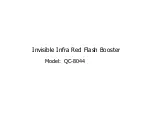
104
Piranha4 4K Camera Color User's Manual
03-032-20180-00
Teledyne DALSA
Appendix D: The Sensor Window
Cleaning and Protecting Against Dust, Oil, and Scratches
The sensor w ind ow is p art of the op tical p ath and shou ld be hand led like other op tical com p onents, w ith
extrem e care. Du st can obscu re p ixels, p rod u cing d ark p atches on the sensor resp onse. Du st is m ost
visible w hen the illu m ination is collim ated . The d ark p atches shift p osition as the angle of illu m ination
changes. Du st is norm ally not visible w hen the sensor is p ositioned at the exit p ort of an integrating
sp here, w here the illu m ination is d iffu se. Du st can norm ally be rem oved by blow ing the w ind ow su rface
u sing an ionized air gu n. Oil is u su ally introd u ced d u ring hand ling. Tou ching the su rface of the w ind ow
barehand ed w ill leave oily resid u es. Using ru bber fingercots an d ru bber gloves can p revent
contam ination. H ow ever, the friction betw een ru bber and the w ind ow m ay p rod u ce electrostatic charge
that m ay d am age the sensor. To avoid ESD d am age and to avoid introd u cing oily resid u es, avoid
tou ch ing the sensor. Scratches d iffract incid ent illu m ination. When exp osed to u niform illu m ination, a
sensor w ith a scratched w ind ow w ill norm ally have brighter p ixels ad jacent to d arker p ixels. The location
of these p ixels w ill ch ange w ith the angle of illu m ination.
An important note on w indow blemishes:
When flat field correction is p erform ed , w ind ow cleanliness is p aram ou nt. The figu re below show s an
exam p le of w hat can hap p en if a blem ish is p resent on the sensor w ind ow w hen flat field correction is
p erform ed . The blem ish w ill cast a shad ow on the w afer. FFC w ill com p ensate for this shad ow by
increasing the gain. Essentially FFC w ill create a w hite sp ot to com p ensate for the d ark sp ot (shad ow ). As
long as the angle of the incid ent light rem ains u nchanged then FFC w orks w ell. H ow ever w hen the angle
of incid ence changes significantly (i.e. w hen a lens is ad d ed ) then the shad ow w ill shift and FFC w ill
m akes things w orse by not correcting the new shad ow (d ark sp ot) and overcorrecting w here the shad ow
u sed to be (w hite sp ot). While the d ark sp ot can be p otentially cleaned , the w hite sp ot is an FFC artifact
that can only be corrected by another FFC calibration.












































